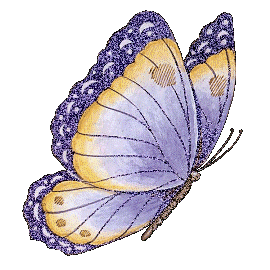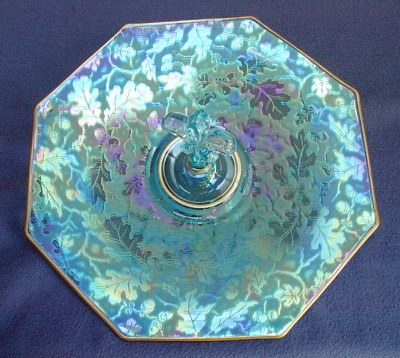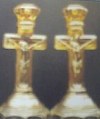Fostoria - Part 1
FOSTORIA'S CARNIVAL GLASS
In our more than 30 years of following and becoming more deeply involved in the
“passion” called Carnival Glass, we have “saved” MUCH in the way of
history related to the Glass itself. During the time Leon Spangler, a printer by trade, one-time prominent collector, and for a time, Editor of the Keystone Carnival Glass Club newsletter; printed a series of
articles directed towards the producers of Carnival Glass. They are well worth taking another look at. As new collectors arrive on the scene, history takes on a renewed importance ! (Be mindful that this account was written BEFORE Fostoria closed.)
The Fostoria Glass Company is the oldest, largest, and best known manufacturer of handmade glassware still in operation, having survived most of their competitors in the Ohio Valley area. During the last quarter of the 19th century, many factories were built in the tri-state area of Ohio, West Virginia and Pennsylvania, for it was rich in sand and the new, cheaper, more efficient natural gas.
Fostoria Glass Co. began operation in 1887 at a factory in Fostoria, Ohio-hence the name. The city of Fostoria promised a good supply of natural gas at a very low rate. However, about four years later, the situation changed and Fostoria moved to a new site across the river to Moundsville, West Virginia. The founders had been using nearby Wheeling as their base of operations so, in a sense, the company came home to stay.
The new factory site in Moundsville was discovered to be undermined with quicksand, but the company went on, not only to build on rock brought from the surrounding area to make the foundation secure, but an even stronger rock of administrative leaderships. The first elected president of the company was L.B. Martin, and the secretary was W.S. Brady, who together are considered the founders of Fostoria. The company continued to forge ahead in the highly competitive glass field with the leadership of William A.B. Dalzell, who was elected the second president in 1902. He served until 1928. His son, William F. Dalzell, served as president from 1945-1958, and his grandson, David Beatty Dalzell, has served the company as president since 1968.
When the new factory was built in Moundsville, it had one furnace with a capacity of 14 pots of glass. The company followed the trend of many other handmade glass factories by going heavily into production in color in 1924. The company was greatly expanded in 1925 to include five furnaces, covering half a million square feet of floor space. With 650 workmen, they were second only to Cambridge in handmade glass production.
The first piece of glass made when the factory began production in 1887 was a salt cellar; however, their early reputation was based on their heavy production of oil lamps. They had hundreds in their line, many of them hand-painted in the era of what is now known as the “Gone-With-The-Wind” lamp. They also made a large one of hand-decorated opal (milk glass) wares.
*Apparently Fostoria did not produce carnival glass, but there are Fostoria glassware pieces which were iridized by the “cold” process and , therefore, of interest to the carnival collector. These pieces are known to collectors as the “Brocaded” patterns. These designs were made by the acid-etching process (not pressed), but in a reverse of the usual technique, much in the manner of Steuben's acid-cut-back. The process differed from Steuben's in that only one color was used, and the glass was thinner. The technique was known as “Brocade Plate Etching”, and is a particularly beautiful process on stemware. Relatively few pieces were iridized.
Patterns in the Brocade line are shown in Hazel Marie Weatherman's excellent book: “FOSTORIA-Its First Fifty Years.” Published in 1972, its 352 pages reproduce 700 actual pages from original Fostoria catalogues.
The Brocade etching patterns included the “Grape” pattern, plate etching # 287, made in blue and orchid in 1927-29, and in green from 1927-1930. Many pieces were made, including bowls, compotes, ice buckets, candlesticks, vases, etc. A “Cupid” pattern, plate etching #288, was introduced in 1927 also, in amber, blue, green and ebony. Items made in this pattern include a clock, perfume bottles, and a puff (powder) box.
The “Paradise” pattern, plate etching #289, was introduced in 1927, discontinued in 1930. It was also presented under the pattern name of “Victoria”, decoration #71, when sold as “Mother of Pearl” iridescent.
Perhaps the most popular and most extensive Brocade line was the “Oak Leaf” pattern, plate etching #290, which was presented as “Oak Wood”, decoration #72, when the azure (green) color was iridized and trimmed with gold. This pattern was introduced in 1928 and discontinued in 1931. It was also made in rose (dawn), ebony and crystal. The item most often found by carnival collectors in this pattern appears to be the small Window Vase & Cover (#2373). The cover is crystal, with holes for insertion of cut flowers.
In her “Seventh Book on Carnival Glass”, Marion Hartung illustrates Fostoria's “Oak Wood” pattern under the name of “Brocaded Acorns”. She also illustrates another pattern she called “Brocaded Daffodils.” This is not illustrated in Mrs. Weatherman's Fostoria book, although the pattern name is noted in the index as being a Fostoria pattern, but does not state if the pattern was cut, etched or pressed.
In her “Fifth Book” Mrs. Hartung illustrates another brocade etching which she called “Brocaded Palms.”This pattern is noted in Weatherman's Fostoria book as the “Palm Leaf” design, but the items are not illustrated. The Palm Leaf pattern was brocade etching #291, and was made in rose and green, with iridescence and gold edge.
The majority of Fostoria's “Iridescent Glassware, All-over Decoration” was made in the late 1920's. It was given a new name near the end of its production period, “Mother-of-Pearl”, and this was particularly striking in stemware with iridescent bowls and colored stems. Additional patterns produced in this type of design, with iridescence, were introduced as “Autumn Glow” (in amber) and “Spanish Lustre”. Illustrations of these are not available.
The Fostoria iridized pieces are fine enough to be considered art glass and, in fact, some have been attributed to Tiffany. They are an interesting addition to any fine carnival glass collection.
Dean & Diane Fry---10/03





Should you care to contact the Frys, their email address is:
Search Our Sites
back to Carnival Glass 101
Our other sites you may enjoy:
Everything you EVER wanted to know about Indiana Glass
Great Reference for Newer Carnival Glass.
Complete Glassware Catalogs Available to Download
Questions? Comments? Suggestions? Broken Links? Corrections?
Your Friendly Webmaster is here to help!

